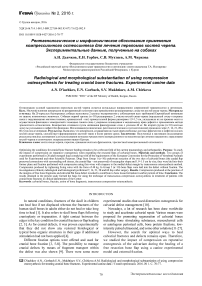Radiological and morphological substantiation of using compression osteosynthesis for treating cranial bone fractures. Experimental canine data
Автор: Diachkov Aleksandr Nikolaevich, Gorbach Elena Nikolaevna, Mukhtiaev Sergei Vasilevich, Chirkova Aleftina Mikhailovna
Журнал: Гений ортопедии @geniy-ortopedii
Рубрика: Оригинальные статьи
Статья в выпуске: 2, 2016 года.
Бесплатный доступ
Optimizing the conditions for cranial bone fracture healing remains to be a relevant field of the current traumatology and orthopaedics. Purpose. To study the impact of compression on reparative osteogenesis when engrafting the resected flaps of calvarial bones. Materials and methods. Two groups of experiments performed in 20 adult mongrel dogs complying with all the requirements of the European Convention for the Protection of Vertebrate Animals used for Experimental and other Scientific Purposes. Dogs from Group 1 (n=10) underwent resection of the two sites of calvarial bones (the caudal flap preserved connections with surrounding soft tissues, the cranial flap - not preserved) of rectangular shape and 1.9×1.5 cm by size, they were laid into their former place and fixation performed with compression using thin wires with stoppers to the medial defect margin by transosseous osteosynthesis method. Compression produced by tightening fixing wires with the force of 40 kg. In Group 2 (n=10) bone flaps were laid into the defect without fixation. The investigations (clinical, radiological and histological) performed 7, 14, 21, 28 and 60 days after surgery. Results. Compression produced at the junction of the margins of free bone fragments and calvarial flat bone defect revealed to contribute to bone tissue formation in earlier periods of time. Conclusion. The results obtained in the present study formed the basis for using the technique of transosseous compression osteosynthesis in treatment of patients with cranial bone fractures in clinical departments of the Center.
Calvarial bones, fracture, union of bone fragments, transosseous compression osteosynthesis
Короткий адрес: https://sciup.org/142121897
IDR: 142121897 | УДК: [616.714.1-001.5-089.227.84-003.93-073.7:612]-092.9 | DOI: 10.18019/1028-4427-2016-2-70-77
Текст научной статьи Radiological and morphological substantiation of using compression osteosynthesis for treating cranial bone fractures. Experimental canine data
In natural conditions, fractures of the skull in children can heal fast if not displaced whereas the fractures of the human skull bones in adults either do not heal or take long time to heal [1]. It also refers to skull bone flaps following cranioplasty or trepanation. A tight contact between the edges is the key condition for cranial fracture or flap healing [2, 3]. As for cranial defects, it was proven experimentally that they did not show any restored histological or typical bone organic structures in their gaps if additional stimulation had not been applied [4].
Different fixation options were offered and used for cranial bone fixation [3, 5-8]. The possibility to manage cranial defects by means of fragment transport within the defect was also shown [9]. There were some more
experimental studies that used distraction osteogenesis for calvarial defect management [10].
Nowadays, a lot of research has been done worldwide to study and accelerate calvarial repair. Various means were proposed for promoting regeneration of calvarial bones including bone stimulating substances, mesenchymal cells or autologous periosteal cells, bone protein fractions, low-intensity pulsed ultrasound, and some other solutions [11-27].
However, the search for optimal ways to heal calvarial fractures and defects remains open. Therefore, we studied the impact of compression on reparative osteogenesis of the calvarium during the healing of a free resection bone flap using a canine experimental model and external fixation.
Ш D'iachkov A.N., Gorbach E.N., Mukhtiaev S.V., Chirkova A.M. Radiological and morphological substantiation of using compression osteosynthesis for treating cranial bone fractures. Experimental canine data // Гений ортопедии. 2016. № 1. С. 70-77.
MATERIALS AND METHODS
Our study used sixteen experimental adult mongrel dogs in the age from one to two years old and weighing from eight to 10 kg that were divided into group 1 (n=8) and control group 2 (n=8). Two bone flaps were resected in the calvarium of each animal.
In group 1, the technique ran as follows. Two 1.5-mm Kirshner wires were drilled through the frontal bone tuberosity and crossed at an angle of 90 to 120 degrees (Fig 1). One more wire passed in the frontal plane through the occipital crest. Those wires were attached to the Ilizarov apparatus ring through wire fixation bolts and were tensioned using a wire tensioner with the force from 80 to 100 kg. Then, soft tissues on the head were cut along the sagittal line. On the left side from the line, the soft tissues were lifted and a rectangular free bone flap was resected which sized 1.9 x 1.5 cm. One more rectangular bone flap of the same size was cut below the first one in the caudal direction. But it remained linked to the underlying soft tissues. Both the free bone flap and the non-free bone flap were re-embedded. Two 1-mm Kirshner wires were bent Z-like at 90 degrees before they had been inserted into the flaps. Then they were drilled into the flaps in such a way that the wire bending could press the lateral flap side. The thin wires were fastened to the Ilizarov apparatus ring and compression equal to 40 kg was applied in the medial direction to the maternal bone rim using a graduated wire tensioner from the Ilizarov fixator set.
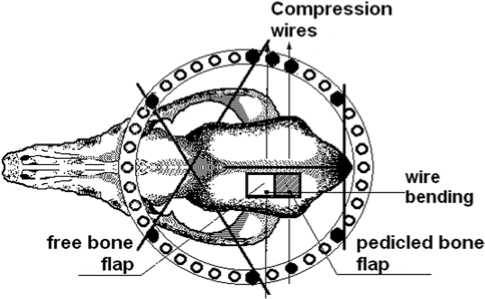
Fig. 1. Diagram of bone flaps and their fixation with wires
Similar bone flaps were produced in the control group 2 (n=8) and fixed in the same way as in the study group but no compression was used in that group.
All the dogs were well cared during the experiment. We observed their behavior, appetite, and mobility. Special care was taken to treat the wounds and the skin round the wires. Due to head trauma, the dogs started to move on the second postoperative day and conducted themselves as usual following one week post- surgery.
Radiographic images were taken every week of the experiment with the aids of the Premium Vet system (Sedecal S.A., Madrid, Spain).
Two dogs from each group were euthanized after seven, 14, 28 and 60 postoperative days using the lethal doses of sodium thiopental. After euthanasia, the skull area that included bone flaps was separated alongside with the surrounding maternity bone and dura mater. The harvested material was fixed in a 10 % solution of neutral formalin for 20 days. Upon the period of decalcination in the hydrochloric and formic acids, the segments on each docking side of the free bone flaps with the adhered maternity bone and the area between the two bone flaps were cut out. Dehydration of the harvested segments in the alcoholic solutions of ascending concentrations followed, and upon its completion the segments were placed into celloidin.
Histologocal sections were prepared using a sledge microtome (Reichert-Jung, Germany). They were stained with haematoxilin/eosin (Serva GbH, Germany). The histological study was performed on a big Opton microscope (Carl Zeiss, Germany). Digital images of the histological sections were processed using the DiaMorph complex (DiaMorph, Russia).
Interventions, animal care and euthanasia conformed to the requirements of the European Convention for the Protection of Vertebrate Animals used for Experimental and other Scientific Purposes (Strasbourg, 18.03.1986); Principles of laboratory animal care (NIH publication No. 85-23, revised 1985), as well as the national laws.
The study was approved by the ethics board of the institution.
RESULTS
This paper presents the results that refer to the calvarial free bone flap repair. We obtained the following
radiographic and morphological findings at the time-points studied (Table 1).
Table 1
Radiographic and morphological findings of resection free bone flap repair at the time-points studied
|
Experiment time-point |
Group 1 |
Group 2 |
||
|
X-ray findings |
Histological findings |
X-ray findings |
Histological findings |
|
|
Day 7 |
Hardly visible fissure between the medial flap edge and the maternal bone; clearly seen fissures at other three flap edges with light shadows inside them (Fig. 2, a). |
Slightly detected fissure between the medial flap edge and maternal bone; 3-mm gap filled in with granulation tissue at lateral flap edge; lack of nuclei in some of free bone flap osteocytes; thin layer of reticulofibrous bone tissue on the lateral flap surface; loose fibrous connective tissue of high cell density along the posterior flap edge; hematoma between the dura mater sheath and the flap; microvessels and loose connective tissue between the flap and the dura mater sheath; osteogenic response of the endosteum cells of the flap and maternal bone (Fig. 3, a). |
Clearly visible fissures between the maternal bone and the free flap on all four sides and light shadows in them (Fig. 2, b). |
Average gap of 2 mm between the medial edge of the flap and the maternal bone with loose connective tissue of high cell density and areas of granulation tissue inside it; lateral gap of approximately 1 mm filled in with loose connective tissue; lack of nuclei in some of free bone flap osteocytes; osteogenic response of endosteum cells of the flap and maternal bone (Fig. 3, b). |
Continued Table 1
Radiographic and morphological findings of resection free bone flap repair at the time-points studied
|
Day 14 |
More expressed gap between the medial flap edge and maternal bone due to bone resorption caused by compression; increased shadows in other three gaps between the maternal bone and the flap edges (Fig. 4, a). |
0.5 to 0.7-mm gap between the medial flap edge and the maternal bone; loose connective tissue and reticular fibrous bone tissue in it; one to 1.5-mm thick bone substance layer on the maternity bone from the side of the medial flap edge presented as trabecular bone tissue of reticular fibrous structure; wide layer of well vascularised connective tissue and big foci of hemorrhage between the flap and the dura mater (Fig. 5, a). |
Clearly visualized gaps between the free flap and the maternal bone on all the sides (Fig. 4, b). |
0.2-0.6-mm wide gap between the maternity bone and the medial free flap edge filled in by mainly connective tissue with some reticular fibrous bone areas due to weak endosteal and periosteal response; lack of nuclei in some of free bone flap osteocytes; wide layer of well vascularised connective tissue bound to the dura mater (Fig. 5, b). |
|
Day 28 |
Marked shadows of the regenerated bone well observed in the gap between the medial flap edge and the maternal bone (Fig. 6, a). |
Trabecular bone tissue in the gap between the medial free flap edge and the maternity bone; prevailing connective tissue in the lateral gap; lack of nuclei in some free bone flap osteocytes; fibrous reticular tissues and fat bone marrow in the intertrabecular spaces; resorption of the lateral maternal bone edge; well vascularized connective tissue on the interior flap surface bound to the dura mater (Fig. 7, a). |
Slight shadows in the gaps along all sides of the free flap (Fig. 6, b). |
6-mm gap between the free flap medial edge and the maternal bone, vascularized connective tissue in the gap between the lateral flap edge and the maternal bone; thin bone substance on the maternal bone edges; unstained osteocytes nuclei; marked endosteal osteogenesis on the free flap edges; osteoclastic resorption on the exterior flap surface; connective tissue on the inferior surface bound to the dura mater (Fig. 7, b). |
|
Day 60 |
Almost invisible docking between the medial side of the free flap and the maternal bone, small fissures at the other three flap sides (Fig. 8, a). |
Bone union between the medial side of the free flap and the maternal bone; connective tissue in the gap at the lateral free flap side; hemopoietic fat bone marrow, areas of reticular tissue and capillaries of sinusoid type with widened lumena in the intertrabecular spaces of the regenerated bone featuring trabeculas of laminar structure (Fig. 9, a). |
Marked gap between the medial side of the free flap and the maternal bone (Fig. 8, b). |
Union through bridging with mixed osseous and connective tissues between the medial side of the free flap and the maternal bone (Fig. 9, b). |
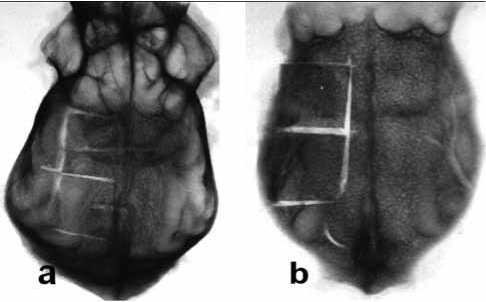
Fig. 2. X-rays on day 7 after the surgery: a – group1, b – control group 2
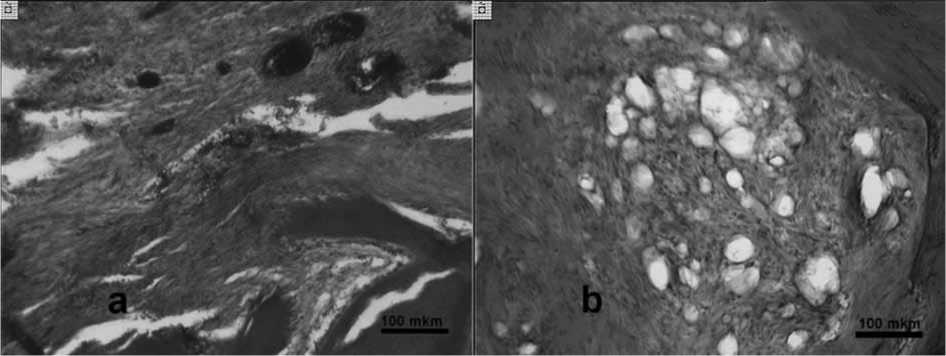
Fig. 3. Histological finding on day 7: a – connective tissue ingrowth from the side of the dura mater, trabeculae of the reticulofibrous bone tissue on the surface of the sawn section; b – endosteal response in the free flap in group 2. Hematoxilin and eosin staining. Magnification × 63
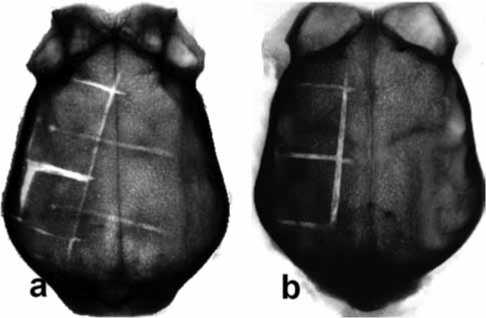
Fig. 4. X-rays on day 14 after the surgery: a – group1, b – control group 2
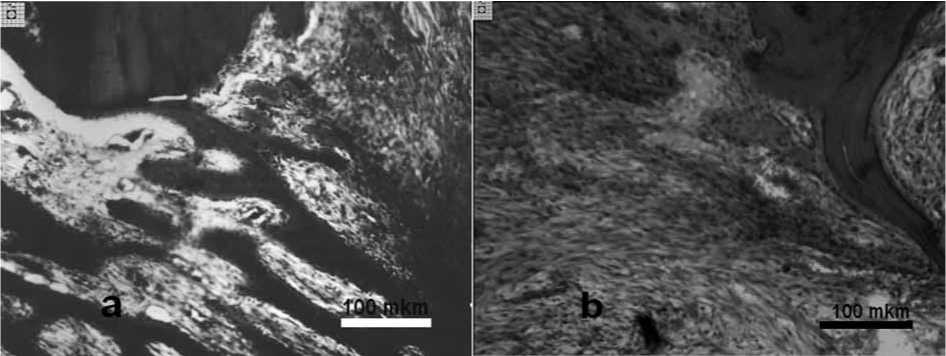
Fig. 5. Histological findings on day 14: a – bone regeneration on the maternal bone surface at the medial flap side in group 1; b – bone trabeculae on free bone flap section and connective tissue in the gap in group 2. Hematoxilin and eosin staining. Magnification × 63

Fig. 6. X-rays on day 28 after the surgery: a – group1, b – control group 2
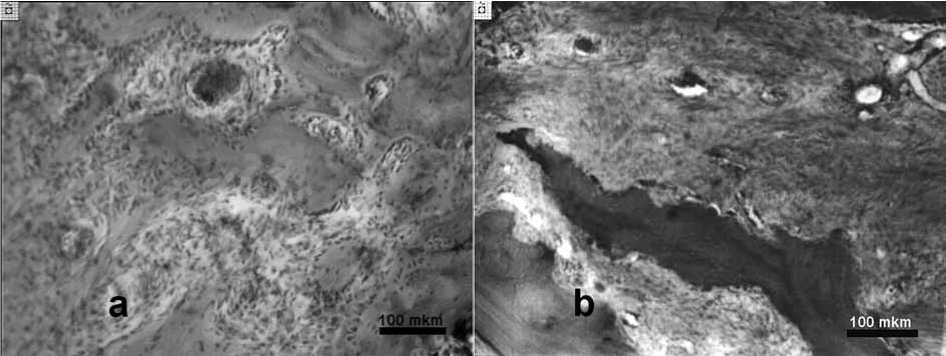
Fig. 7. Histological findings on day 28: a – bone trabeculae oon the free bone flap section surface in group1; b – connective tissue in the gap between the medial edge of free flap and maternal bone in group 2. Hematoxilin and eosin staining. Magnification × 63
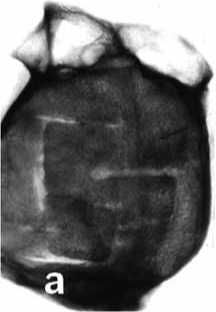
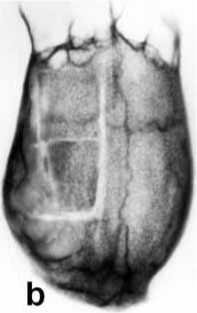
Fig. 8. X-rays on day 60 after the surgery: a – group 1, b – control group 2
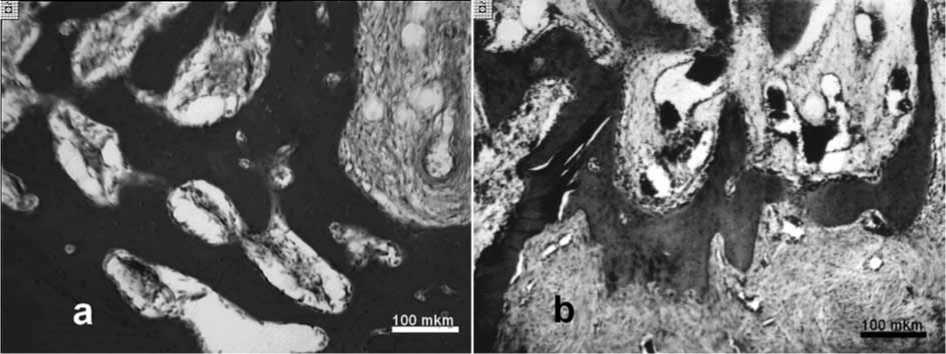
Fig. 9. Histological findings on day 60 after the surgery: a – bone union at the medial free bone flap side in group 1; b – union through bone and connective tissue in group 2. Hematoxilin and eosin staining. Magnification × 63
There were no any signs of brain sheath or matter primary intention. Some serous discharge round wires was inflammation in any of the dogs. Wounds healed with regularly treated with antiseptic solutions.
DISCUSSION
Calvarial bones feature low capacity for regeneration [2, 4]. Posttraumatic histogenesis in the calvarium runs as a replacement regeneration that results mostly in the fibrous connective tissue [4]. Our experiment showed that even two months after the start of the experiment this phenomenon was observed and continued in the control group.
The studies that had used other experimental models for studying cranial bone regeneration showed that the main source of regeneration in the cranium was the periosteum [2, 27, 28]. In a growing organism, the dura mater was shown to be involved into regeneration process alongside with the periosteum. [2, 27]. Our study revealed that the cambium osteogenic cells of the periosteum, endosteum as well as poorly differentiated perivascular cells under resorption at the rims of the maternity bone and bone flaps participated in the healing process that featured osteogenic differentiation. However, this process was more active under compression.
It is known that bone repair depends on several mechanical signals that include stability of fixation and the force that is transmitted to the fracture site during loading [29, 30]. Those signals have an effect on the quality of new regenerated bone and velocity of neoosteogenesis. In our series, compression was the main mechanical stimulus for free bone flap repair. However, the morphological difference of bone repair between the groups at seven days’ time-point of the experiment was minimal, but the width of the gaps was different in the groups due to compression
loading for tighter contact of the medial free bone flap side with the maternal bed in group 1. Nevertheless, the differences in the morphogenesis between the bone and connective tissues were clearly seen in the gaps on the following stages of the experiment.
It is also known that the mechanical impact on the cell level is similar to the effect of bone morphogenic proteins (BMP) and has an influence on cell proliferation and differentiation [31]. It inevitably alters the binding links of the receptors with the proteins of the extracellular bone matrix. The redistribution of the balance of the mechanical forces in the cells that is caused either by the mechanical impact or the interrelationship of cell receptors with the proteins of the extracellular bone matrix involves the cell structures, in particular, the structural reorganization of the cytoskeleton components. Moreover, the mechanical loading induces the increase of the content of the mechano growth factor (MGF) and its receptors in osteogenic cells that finally influence cell proliferation due to this mechanical effect [32, 33]. Those findings in our study were reflected by the increase in the density of poorly differentiated cells in the gap connective tissue in the early experiment periods, more expressed in group 1.
The pushing mechanism of any bone repair is bone injury that results in the intensification of osteoclastic resoption [34]. Alongside, non-collagen proteins or BMPs that regulate osteogenesis are released thereby [35]. Poorly
differentiated perivascular cells or pericytes are the target cells for osteoinductive BMPs, and that chain results in the transformation of the pericytes into preosteoblasts [36]. In our opinion, the compression created by the external device provided bone resoption and additional release of those proteins on the one hand. On the other hand, the reduced distance between the medial free flap side and the maternal bone became more optimal for the action of those osteogenesis regulating proteins. The increase of osteoclastic resorption in group 1 with the use of compression osteosynthesis initiated the reparative process in the periosteum and endosteum that was expressed by trabecular areas structured as reticular fibrous bone tissue on the surface of the rims at the compression docking site on day 14, whereas the periosteal and endosteal responses were observed only in the flap itself in the control group 2.
The studies show that the healing of calvarial defects and fractures depends on the activity of angiogenesis in the area of injury [37-39]. Timely neovascularisation promotes intramembraneous osteogenesis. We found a large number of capillary-type vessels in the gap under compression and reticular fibrous bone tissue in that area on day 28 of the experiment. Therefore, we suppose that compression promoted the VEGF release resulting in better revascularisation and osteogenesis in group 1.
We conclude that compression that is created at the junction of the calvarial free bone flap and maternal bone promotes early bone formation. Our experimental findings could be used in clinical settings for repair of calvarial fractures and trepanation defects. This compression effect on calvarial repair may be created by other methods of bone fixation.
Список литературы Radiological and morphological substantiation of using compression osteosynthesis for treating cranial bone fractures. Experimental canine data
- Камалов И.И. Дифференциальная рентгенодиагностика заболеваний костей черепа//Советская медицина. 1985. № 6. С. 119-123.
- Осипенкова Т.К. Гистоморфология заживления переломов, трещин и дефектов костей свода черепа//Судебно-мед. экспертиза. 2004. № 2. С. 3-4.
- Skull bone flap fixation -comparative experimental study to assess the reliability of a new grip-like titanium device (Skull Grip) versus traditional sutures: technical note/S. Chibbaro, O. Makiese, G. Mirone, D. Bresson, D. Chauvet, P. Di Emidio, R. Galzio, B. George//Minim. Invasive Neurosurg. 2009. Vol. 52, N 2. P. 98-100.
- Деев Р.В. Анализ репаративной регенерации костей крыши черепа//Морфология. 2007. Т. 132, № 6. С. 64-69.
- Cranial bone flap fixation using a new device (Cranial LoopTM)/K. Van Loock, T. Menovsky, N. Kamerling, D. De Ridder//Minim. Invasive Neurosurg. 2011. Vol. 54, N 3. P. 119-124.
- Winston K.R., Wang M.C. Cranial bone fixation: review of the literature and description of a new procedure//J. Neurosurg. 2003. Vol. 99, N 3. P. 484-488.
- Skull bone flap fixation -reliability and efficacy of a new grip-like titanium device (Skull Grip) versus traditional sutures: a clinical randomized trial/S. Chibbaro, O. Makiese, D. Bresson, S. Hamdi, J.F. Cornelius, J.P. Guichard, A. Reiss, S. Bouazza, E. Vicaut, A. Ricci, R. Galzio, P. Poczos, B. George, M. Marsella, P. Di Emidio//Minim. Invasive Neurosurg. 2011. Vol. 54, N 5-6. P. 282-285.
- Chibbaro S., Tacconi L. Use of skin glue versus traditional wound closure methods in brain surgery: A prospective, randomized, controlled study//J. Clin. Neurosci. 2009. Vol. 16, N 4. P. 535-539.
- Shevtsov V.I., Diachkov A.N., Khudiaev A.T. Substitution of cranial defects by bone transport. In: M.L. Samchukov, J.B. Cope, A.M. Cherkashin. Craniofacial Distraction Osteogenesis. St. Louis, United States: Elsevier, Health Sciences Division, 2001. P. 547-560.
- Transport disc distraction osteogenesis for the reconstruction of a calvarial defect/I.S. Yun, H.Y. Mun, J.W. Hong, E.J. Cho, D.G. Woo, H.S. Kim, Y.O. Kim, B.Y. Park, D.K. Rah//J. Craniofac. Surg. 2011. Vol. 22, N 2. P. 690-693.
- Biomechanical evaluation of rat skull defects, 1, 3, and 6 months after implantation with osteopromotive substances/L. Jones, J.S. Thomsen, L. Mosekilde, C. Bosch, B. Melsen//J. Craniomaxillofac. Surg. 2007. Vol. 35, N 8. P. 350-357.
- Регенерация костей черепа взрослых кроликов при имплантации коммерческих остеоиндуктивных материалов и трансплантации тканеинженерных конструкций/А.В. Волков, И.С. Алексеева, А.А. Кулаков, Д.В. Гольдштейн, С.А. Шустров, А.И. Шураев, И.В. Арутюнян, Т.Б. Бухарова, А.А. Ржанинова, Г.Б. Большакова, А.С. Григорьян//Клеточные технологии в биологии и медицине. 2010. № 2. С. 72-77.
- Injectable reactive biocomposites for bone healing in critical-size rabbit calvarial defects/J.E. Dumas, P.B. BrownBaer, E.M. Prieto, T. Guda, R.G. Hale, J.C. Wenke, S.A. Guelcher//Biomed. Mater. 2012. Vol. 7, N 2. P. 024112.
- Reconstruction of rat calvarial defects with human mesenchymal stem cells and osteoblast-like cells in poly-lactic-co-glycolic acid scaffolds/C. Zong, D. Xue, W. Yuan, W. Wang, D. Shen, X. Tong, D. Shi, L. Liu, Q. Zheng, C. Gao, J. Wang//Eur. Cell. Mater. 2010. Vol. 20. P. 109-120.
- Chemical control of FGF-2 release for promoting calvarial healing with adipose stem cells/M.D. Kwan, M.A. Sellmyer, N. Quarto, A.M. Ho, T.J. Wandless, M.T. Longaker//J. Biol. Chem. 2011. Vol. 286, N 13. P. 11307-11313.
- Acute skeletal injury is necessary for human adipose-derived stromal cell-mediated calvarial regeneration/B. Levi, A.W. James, E.R. Nelson, M. Peng, D.C. Wan, G.W. Commons, M. Lee, B. Wu, M.T. Longaker//Plast. Reconstr. Surg. 2011. Vol. 127, N 3. P. 1118-1129.
- Osteogenesis induced by autologous bone marrow cells transplant in the pediatric skull/F. Velardi, P.R. Amante, M. Caniglia, G. De Rossi, P. Gaglini, G. Isacchi, P. Palma, E. Procaccini, F. Zinno//Childs Nerv. Syst. 2006. Vol. 22, N 9. P. 1158-1166.
- Effect of recombinant human bone morphogenetic protein-2, -4, and -7 on bone formation in rat calvarial defects/S.J. Hyun, D.K. Han, S.H. Choi, J.K. Chai, K.S. Cho, C.K. Kim, C.S. Kim//J. Periodontol. 2005. Vol. 76, N 10. P. 1667-1674.
- Skull bone regeneration in nonhuman primates by controlled release of bone morphogenetic protein-2 from a biodegradable hydrogel/Y. Takahashi, M. Yamamoto, K. Yamada, O. Kawakami, Y. Tabata//Tissue Eng. 2007. Vol. 13, N 2. P. 293-300.
- BMP-2-mediated regeneration of large-scale cranial defects in the canine: an examination of different carriers/C.R. Kinsella Jr., M.R. Bykowski, A.Y. Lin, J.J. Cray, E.L. Durham, D.M. Smith, G.E. DeCesare, M.P. Mooney, G.M. Cooper, J.E. Losee//Plast. Reconstr. Surg. 2011. Vol. 127, N 5. P. 1865-1873.
- In vivo bone regenerative effect of low-intensity pulsed ultrasound in rat calvarial defects/A. Hasuike, S. Sato, A. Udagawa, K. Ando, Y. Arai, K. Ito//Oral Surg. Oral Med. Oral Pathol. Oral Radiol. Endod. 2011. Vol. 111, N 1. P. e12-e20.
- Latex use as an occlusive membrane for guided bone regeneration/C. Ereno, S.A. Guimarães, S. Pasetto, R.D. Herculano, C.P. Silva, C.F. Graeff, O. Tavano, O. Baffa, A. Kinoshita//J. Biomed. Mater. Res. A. 2010. Vol. 95, N 3. P. 932-939.
- Osteoconductive effects of 3 heat-treated hydroxyapatites in rabbit calvarial defects/P. Pripatnanont, T. Nuntanaranont, S. Vongvatcharanon, S. Limlertmongkol//J. Oral Maxillofac. Surg. 2007. Vol. 65, N 12. P. 2418-2424.
- The effect of a fibrin-fibronectin/beta-tricalcium phosphate/recombinant human bone morphogenetic protein-2 system on bone formation in rat calvarial defects/S.J. Hong, C.S. Kim, D.K. Han, I.H. Cho, U.W. Jung, S.H. Choi, C.K. Kim, K.S. Cho//Biomaterials. 2006. Vol. 27, N 20. P. 3810-3816.
- Scale-up of MSC under hypoxic conditions for allogeneic transplantation and enhancing bony regeneration in a rabbit calvarial defect model/T.L. Yew, T.F. Huang, H.L. Ma, Y.T. Hsu, C.C. Tsai, C.C. Chiang, W.M. Chen, S.C. Hung//J. Orthop. Res. 2012. Vol. 30, N 8. P. 1213-1220.
- Evaluation of BMP-2 gene-activated muscle grafts for cranial defect repair/F. Liu, R.M. Porter, J. Wells, V. Glatt, C. Pilapil, C.H. Evans//J. Orthop. Res. 2012. Vol. 30, N 7. P. 1095-1102.
- Osteogenesis in calvarial defects: contribution of the dura, the pericranium, and the surrounding bone in adult versus infant animals/A.K. Gosain, T.D. Santoro, L.S. Song, C.C. Capel, P.V. Sudhakar, H.S. Matloub//Plast. Reconstr. Surg. 2003. Vol. 112, N 2. P. 515-527.
- Bone formation in rat calvaria ceases within a limited period regardless of completion of defect repair/T. Honma, T. Itagaki, M. Nakamura, S. Kamakura, I. Takahashi, S. Echigo, Y. Sasano//Oral Dis. 2008. Vol. 14, N 5. P. 457-64.
- Goodship A.E., Kenwright J. The influence of induced micromovement upon the healing of experimental tibial fractures//J. Bone Joint Surg. Br. 1985. Vol. 67, N 4. P. 650-655.
- Effects of in vivo mechanical loading on large bone defect regeneration/J.D. Boerckel, Y.M. Kolambkar, H.Y. Stevens, A.S. Lin, K.M. Dupont, R.E. Guldberg//J. Orthop. Res. 2012. Vol. 30, N 7. P. 1067-1075.
- Садофьев И.А., Подгорная О.И. Остеогенная дифференцировка в культуре//Цитология. 1999. Т. 41, № 10. С. 877-885.
- Ingber D.E. Tensegrity: the architectural basis of cellular mechanotransduction//Annu. Rev. Physiol. 1997. Vol. 59. P. 575-599.
- The nuclear localization of MGF receptor in osteoblasts under mechanical stimulation/Q. Peng, J. Qiu, J. Sun, L. Yang, B. Zhang, Y. Wang//Mol. Cell. Biochem. 2012. Vol. 369, N 1-2. P. 147-156.
- Osteoclastic activity begins early and increases over the course of Bone healing/H. Schell, J. Lienau, D.R. Epari, P. Seebeck, C. Exner, S. Muchow, H. Bragulla, N.P. Haas, G.N. Duda//Bone. 2006. Vol. 38, N 4. P. 547-554.
- Kwong F.N., Harris M.B. Recent developments in the biology of fracture repair//J. Am. Acad. Orthop. Surg. 2008. Vol. 16, N 11. P. 619-625.
- Изменение остеоиндуктивной активности костного матрикса в Онтогенезе/Д.Д. Сумароков, М.Б. Швырков, А.Х. Шамсутдинов, Д.В. Гуткин, Н.А. Афанасенко//Онтогенез. 1991. Т. 19, № 5. С. 195-198.
- Intravital microscopic studies of angiogenesis during bone defect healing in mice calvaria/J.H. Holstein, S.C. Becker, M. Fiedler, P. Garcia, T. Histing, M. Klein, M.W. Laschke, M. Corsten, T. Pohlemann, M.D. Menger//Injury. 2011. Vol. 42, N 8. P. 765-771.
- Bone formation and neovascularization mediated by mesenchymal stem cells and endothelial cells in critical-sized calvarial defects/S. Koob, N. Torio-Padron, G.B. Stark, C. Hannig, Z. Stankovic, G. Finkenzeller//Tissue Eng. Part A. 2011. Vol. 17, N 3-4. P. 311-321.
- Angiogenesis in bone regeneration/K.D. Hankenson, M. Dishowitz, C. Gray, M. Schenker//Injury. 2011. Vol. 42, N 6. P. 556-561.

